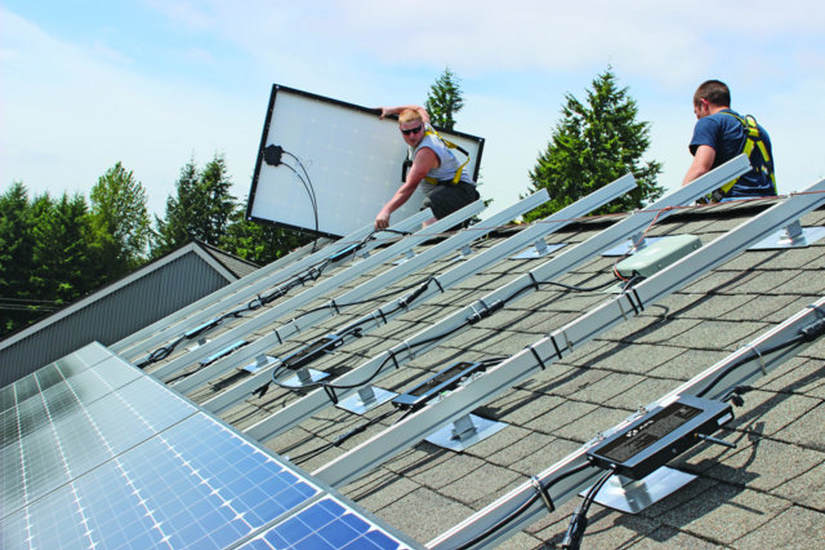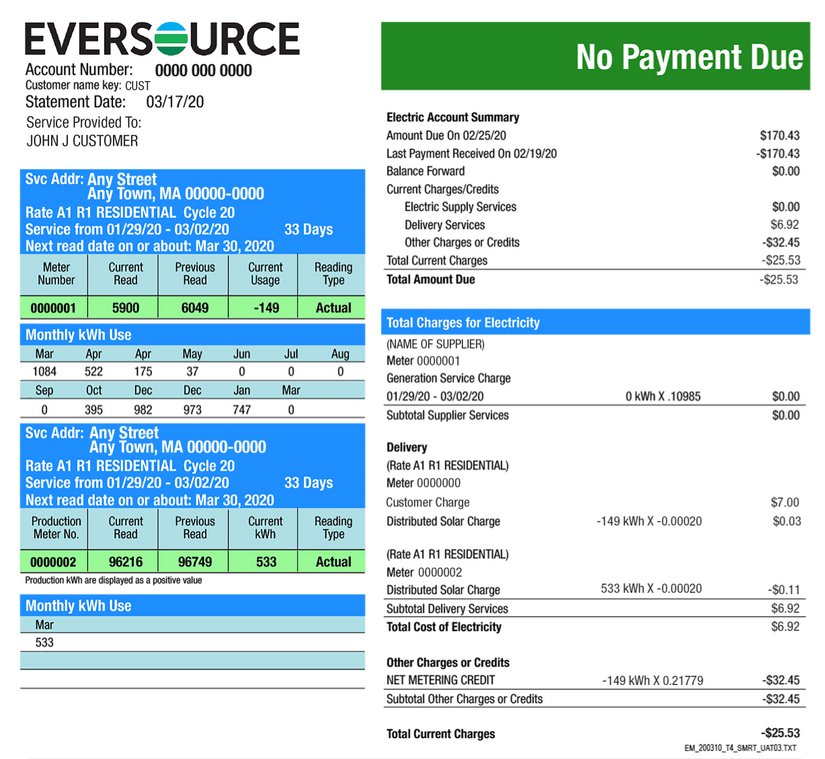Solar Technology in Real Estate
As more homeowners choose to install solar as their source for home energy, REALTORS® need to be knowledgeable to serve their clients - whether it is a buyer, seller, renter, or appraisal.
Self Reliance, a local non-profit organization dedicated to promoting energy efficiency and renewable energy technologies in our region since 1980, assisted CCIAOR with the creation of this resource guide. For more information or questions related to solar renewable energy, please visit selfreliancefuelcoop.org.
What is Photovoltaics?
Often referred to as PV or solar, photovoltaics is a solid-state technology that utilizes panels that collect energy from the sun (photons) and turn it into useful electricity. In homes that are served by an electric utility, such as Eversource, an inverter is necessary to have the solar-produced electricity seamlessly integrate with the electricity system of the house. The inverter takes the direct current of electricity produced by the solar panels and synchronizes it with the sine wave of the alternating current of the utility grid.
Almost all PV systems are connected to the utility grid. When the sun is shining, the solar panels are providing power to the home, however, when the sun is not shining, such as during the night or during a rainstorm, the home is being powered by the grid. Depending upon the size of the system and the electricity usage at the time, the solar panels may produce more or less electricity than the home consumes. Those extra electrons are fed back into the utility grid and spin the customer’s meter backward, providing a credit to be used at another time. Homeowners also have the option of purchasing optional batteries to store access electricity. Battery storage technologies are rapidly evolving.
Understanding Solar Panels
Often, people will indicate that their home has a certain number of panels. However, the number of panels does not determine the size or the amount of energy the system will produce. To understand the size of the system, you will need to know what the panels are capable of producing. Solar panels, or modules, are rated in watts. There are thousands of differently sized modules, many of which can be found here in the Commonwealth of Massachusetts. Each manufacturer has its suite of modules, with older modules tending to have lower wattages. What is key to know is the installed capacity of the system. This information would be found in the customer’s contract with the solar installer or on file with the town’s electrical inspector.
The other factor that plays a large role in the amount of electricity the PV system can produce is the orientation of the system on the roof. PV panels produce the most electricity when facing South and they have abundant, the unshaded sun hitting them from at least 9:00 am to 3:00 pm year-round. Any shift away from a Southerly orientation or shading has an impact on their production. Sometimes a customer will opt to have a larger system installed to make up for the loss in production if the system is facing in a more East, West, or Northerly direction. That being said, a 5-kilowatt system facing South with no shading will produce more electricity than a partially shaded 5-kilowatt system facing Southeast.
Will this system cover all of our electrical needs?
It depends on the usage of electricity in the home. It is important to know the useful information related to electrical appliances that are in the home and if the homeowner is planning to add any more, such as heat pumps or an electric vehicle. Human behavior also plays a role in how much electricity is consumed. One way to gauge if the PV system was covering the home’s load with the previous homeowners is to ask to see the Eversource bill. The second page of that bill offers a 13-month snapshot of kilowatt-hour consumption and will also show the amount of credits the PV system has accrued or if the customer was paying for additional electricity.
A customer can certainly look into options to add to their solar system if they feel that the system is not adequate for their needs.
What are the main components of a PV system?

Source: Solarreviews.com - This image represents a solar system that has a string inverter and optional battery storage shown.
Many PV systems have microinverters, which means there is a small inverter on the back of every single solar panel on the roof. These are helpful if there is shading and they are also popular because they offer a 20-year plus warranty, consistent with the solar panels. The small little boxes with the wires going in and out of them below that are attached to the rails are the microinverters.

Source: solarbuildermag.com
In some cases, homeowners opt to include battery storage in their homes. Batteries are often done in conjunction with a solar system to avoid the need for a fossil-fuel-powered generator (propane, natural gas, or gasoline) to power either critical loads or the whole house.
Batteries enable a home to store the extra electricity for use in a power outage or to help support the utility grid during times of peak demand to help avoid brownouts and blackouts that occur when the demand for electricity is higher than the production or there are issues with the transmission lines. And as the technology matures, some homes may be outfitted with a bidirectional electric vehicle charger, which enables the home to have critical electric loads be powered by the battery in an electric vehicle.

Source: Eversource
Types of Ownership
In Massachusetts, PV has been installed on a regular basis since the beginning of the 2000s.
In the early phase of the industry, outright ownership was the most common way people installed solar. They either took out a home equity line of credit or paid in cash. There were large rebates that were paid to customers based on the production of the system.
On Cape Cod in 2002, the price per installed watt of PV was ~$8.00. The average-sized PV system is between 8 to 10 kilowatts. The cost back then for an 8 kW system would have been $64,000 and a 10 kW system would have been $80,000.
Today, since the cost per watt has come down for a number of reasons, there is a larger spread of price per watt that a customer might find if contracts were solicited. In 2021, the cost per watt can be between $2.50 per watt to ~$4.75 per watt. An 8 kW system today would cost ~$20,000 and a 10 kW system would cost ~$25,000. Ownership of the solar system is definitely more financially beneficial to the homeowner than a lease or 3rd party ownership scenario.
Third-Party Ownership (also known as a Leased System)
This model of ownership became popular in Massachusetts around 2010 and was driven by companies looking to install solar on people’s roofs and sell the power produced by the panels to the homeowner through a power purchase agreement or PPA at a set price for a set amount of time. This model enables the solar developer to utilize the federal solar tax credit, which the homeowner may or may not have the ability to use. Some Homeowners are interested in this model because it often requires no money down.
It is critical when selling a home that the REALTOR® and prospective buyers are aware of if the solar system is owned by a 3rd party because the new owner is most likely required to assume this contract liability.
Maintenance Issues
There are no moving parts in a solar system mounted to the roof and most components are warranted for 20 years. Most solar panels on the market today come with a 20-25 year warranty. If the home has a string inverter, which is one larger inverter, the warranty on these is typically less than 20 years, unless the homeowner has purchased an extended warranty through the manufacturer. However, labor is usually not included in the warranty and must be paid out of pocket by the customer should there be a warranty issue. It is essential to review a copy of the contract and warranty to be certain of what is included and what is not. If you need help discerning these details, most local solar companies can assist or a non-profit organization like Self-Reliance can also offer guidance.
It is important to note that many 3rd party installations that were done by Solar City (now owned by Tesla) are not being warrantied and are connecting homeowners with local solar installers to help customers with issues such as roof leakage, reroofing, and inverter or panel issues.
If roofing repairs or reroofing are in order, it is recommended that a local solar installer, or the contractor who installed the system, be contacted to work with the roofing contractor. It is essential that the solar panels are disconnected properly, removed safely and reinstalled onto the roof, and reconnected electrically in the proper way.
Solar Fields in the MLS
The Cape Cod & Islands MLS evaluates green field data regularly as more information and resources become available. We are currently working with our listing software vendor and the Northeast Energy Efficiency Partnership (NEEP) to create auto-populated fields that will allow for updated information to be entered automatically into the system, which will be provided by the Home Energy Labeling Information Exchange (HELIX). We currently have Solar Leased or Solar Owned fields available for selection by members, as well as the options to select Solar for Fuel type and as a Hot Water Source. We are looking forward to adding more solar-related options in order to add more value to the data of the MLS.
Solar Effect on Home Values
PV Value® is a free solar PV Valuation tool that answers the question of "How much is solar PV worth" and is compliant with the Uniform Standards of Professional Appraisal Practice.
It is available for and being used by real estate appraisers, real estate professionals, homeowners, commercial building owners, home builders, solar installers, green raters, insurance companies, and mortgage lenders in all 50 states along with D.C. and Puerto Rico.
PV Value® allows for the calculation of both the cost and income approach to value and was endorsed by the largest appraiser trade organization, the "Appraisal Institute," as an innovative approach to valuing solar assets.
Self-Reliance
Founded in 1980, Self-Reliance Corporation, is a women-led energy service and education non-profit organization. The staff provides workforce training in renewable energy and building science, as well as energy educational outreach and technical support to help people take action to move toward a low carbon economy while increasing comfort, saving money, and building energy resiliency. If you are considering solar or electrification of appliances, such as heat pumps, electric vehicles, and battery storage, Self-Reliance staff can help you with the information gathering and personalized decision-making process. Self-Reliance staff members have years of experience and technical expertise to share with you.
The office can be reached at 508-563-6633 or reliance@reliance.org.

